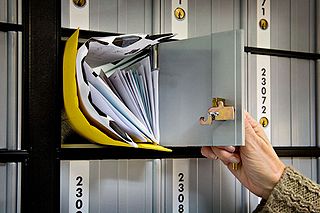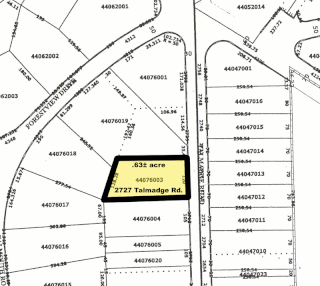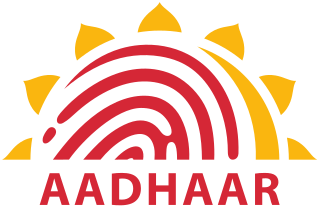
A post office box is a uniquely addressable lockable box located on the premises of a post office.

Subdivisions are the act of dividing land into pieces that are easier to sell or otherwise develop, usually via a plat. The former single piece as a whole is then known as a subdivision. Subdivisions may be simple, involving only a single seller and buyer, or complex, involving large tracts of land divided into many smaller parcels. If it is used for housing it is typically known as a housing subdivision or housing development, although some developers tend to call these areas communities.
A national identification number, national identity number, or national insurance number or JMBG/EMBG is used by the governments of many countries as a means of tracking their citizens, permanent residents, and temporary residents for the purposes of work, taxation, government benefits, health care, and other governmentally-related functions.

A barcode printer is a computer peripheral for printing barcode labels or tags that can be attached to, or printed directly on, physical objects. Barcode printers are commonly used to label cartons before shipment, or to label retail items with UPCs or EANs.
Address geocoding, or simply geocoding, is the process of taking a text-based description of a location, such as an address or the name of a place, and returning geographic coordinates, frequently latitude/longitude pair, to identify a location on the Earth's surface. Reverse geocoding, on the other hand, converts geographic coordinates to a description of a location, usually the name of a place or an addressable location. Geocoding relies on a computer representation of address points, the street / road network, together with postal and administrative boundaries.

A cadastre or cadaster is a comprehensive recording of the real estate or real property's metes-and-bounds of a country. Often it is represented graphically in a cadastral map.

The lot and block survey system is a method used in the United States and Canada to locate and identify land, particularly for lots in densely populated metropolitan areas, suburban areas and exurbs. It is sometimes referred to as the recorded plat survey system or the recorded map survey system.
In the distribution and logistics of many types of products, track and trace or tracking and tracing concerns a process of determining the current and past locations of a unique item or property. Mass serialization is the process that manufacturers go through to assign and mark each of their products with a unique identifier such as an Electronic Product Code (EPC) for track and trace purposes. The marking or "tagging" of products is usually completed within the manufacturing process through the use of various combinations of human readable or machine readable technologies such as DataMatrix barcodes or RFID.
An assessor's parcel number, or APN, is a number assigned to parcels of real property by the tax assessor of a particular jurisdiction for purposes of identification and record-keeping. The assigned number is unique within the particular jurisdiction, and may conform to certain formatting standards that convey basic identifying information such as the property type or location within the plot map.

Aadhaar is a 12-digit unique identity number that can be obtained voluntarily by all residents of India, based on their biometrics and demographic data. The data is collected by the Unique Identification Authority of India (UIDAI), a statutory authority established in January 2009 by the Government of India, under the jurisdiction of the Ministry of Electronics and Information Technology, following the provisions of the Aadhaar Act, 2016.
The Legal Entity Identifier (LEI) is a unique global identifier for legal entities participating in financial transactions. Also known as an LEI code or LEI number, its purpose is to help identify legal entities on a globally accessible database. Legal entities are organizations such as companies or government entities that participate in financial transactions. An individual person may not obtain an LEI. The identifier is used in regulatory reporting to financial regulators and all financial companies and funds are required to have an LEI.
Mailo is a unique form of land tenure in Uganda. Around 9 per cent of the country's land is held under the mailo system, which is similar to freehold. It was set up by the 1900 Buganda Agreement. Idi Amin then made all land publicly owned, and the 1995 Constitution of Uganda reintroduced mailo.
The Pennsylvania State Game Lands Number 249 are Pennsylvania State Game Lands in northeastern Adams County in Pennsylvania in the United States.
The Pennsylvania State Game Lands Number 203 are Pennsylvania State Game Lands located in Allegheny County, Pennsylvania in the United States.
The Pennsylvania State Game Lands Number 189 are Pennsylvania State Game Lands in Beaver County in Pennsylvania in the United States providing hunting, bird watching, cross-country skiing, and other activities.
The Pennsylvania State Game Lands Number 41 are Pennsylvania State Game Lands in Bedford and Blair Counties in Pennsylvania in the United States providing hunting, bird watching, and other activities.
Bhudhaar is a e-governance project that is intended to assign an 11 digit unique number to every land parcel in the state of Andhra Pradesh as part of the "land hub in E-Pragati programme". Bhudhaar is the first in India to address issues in land record management. Union Government of India also implementing Unique Land Parcel Identification Number (ULPIN) Project with the reference from this Bhudhaar Project. Bhuseva Authority, an inter-departmental committee was formulated to implement and monitor the progress. Eventually all land related transactions will use Bhudhaar as single source of truth to reduces land related disputes. On 18 February 2019, the Andhra pradesh Assembly gave its consent to the legal usage of the Bhudhaar Number in land documents. This project is being regularly monitored by AP CM Dashboard which was developed and managed by Real Time Governance Society (RTGS) in real time basis.

The Phoenix Vernal Pools are located in Fair Oaks, California, a suburb of Sacramento city around 20 miles east of the city of Sacramento and north of highway 50. This land consists of seasonally inundated wetlands that form after winter rains. The climate type of Phoenix Vernal Pools is classified as Mediterranean, receiving 24 in (610 mm) of rain per year. The rainwater percolates into the soil until it reaches an impermeable hardpan that causes an elevated water table, forming the vernal pools. The Phoenix Vernal Pool ecosystem is relatively unique as is supports many species of fauna and flora endemic to vernal pools.
Being described as the Aadhaar for land, Unique Land Parcel Identification Number (ULPIN) is a 14-digits alphanumeric unique ID for each and every land parcel in India. Ultimately ULPIN will be used as single source of truth for land records in near future as it is designed to uniquely identify every surveyed land parcel in india based on the Textual records of rights (RoR) along with its corresponding geo coordinates. This ULPIN project concept was taken from Bhudhaar project in Andhra Pradesh and announced in October 2020 with a plan to assign ULPIN to all land parcels in India by March 2022.






